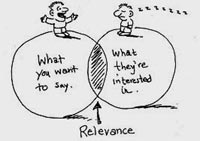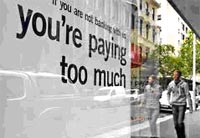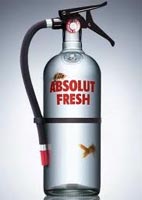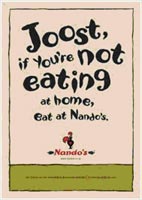We all know how exceptionally powerful great marketing communications can be, other than a unique product design/functionality (i.e. Apple/Gillette) and distribution, it is the most impactful element in the marketing mix. Its ability to establish a brand and keep it foremost in the consumer mind, is unrivalled by most elements of the marketing mix.
At best, advertising (as still one of the most dominant elements of the marketing communication mix) that achieves business objectives is "a hit and a miss affair" for most clients and agencies. Today, this very same principle is starting to apply to social media: by far, the bulk of social media interventions by brands have no impact at all, exactly for the same reasons why most advertising does not work.
Marketing communications and media take up the bulk of marketing spend for almost all brands, yet it is the one area where we still get it "wrong" most of the time. If we compare advertising impact figures from around the world, it is clear that most advertising does not achieve its objectives. This very same principle applies to sponsorships (where the dominate sponsors achieve the bulk of the impact) and today for social media, where even brands like GM withdrew its support from Facebook because it did not see its value.
Yet, it is not because these tools do not work, it is because we use them incorrectly, or do not apply the correct rigour to them.
On average today, a campaign has a greater chance not to work, than to work. A simple anecdote is to ask yourself, "driving to work this morning, how many radio ads can I remember?" Trust me, for most people either none at all or maybe two at the most.
So are there guidelines for making it work better? Or must we live in this space where we as marketers face credibility problems in companies precisely because of such issues?
Having been a marketer, agency person and consultant for many years, there are some guidelines I use - I sum it up in one acronym: DRUMS. It does not take the important role of "gut-feel" away (just "knowing" a campaign will work), but it provides some logical questions we can use to limit our "misses".
Five words: dominant; relevant; unique; memorable and smile (or reactions). If these elements are present, even if just some are present, there is a good chance that a campaign will work.
Whether it is the size of a bone for a dog; being the tallest building or spending most on marketing, size matters - if you can afford it. Very few things buy a greater barrier-to-entry for a brand.
The simplest and easiest way to be noticed, is to "shout louder" than most. This is the basis upon which companies as diverse as Coca-Cola, Proctor & Gamble (P&G), Vodacom, ABSA, and Checkers Shoprite operate. Although size is not a guarantee for success, it is by far the safest way to guarantee dominance of the share-of-mind of the consumer.
I remember working on shampoo brands when P&G entered the market with Head & Shoulders. It quadrupled the category spend overnight, thereby "buying" share-of-mind way above any other brand. Today, it leads the market.
When you review case studies, there is an inverse relationship between category marketing spend and its level of commoditization. If a category stops marketing itself, it declines and its brands decline. This is not a theory, it is a fact. Of course marketing does not only mean marketing communications, it can also be distribution dominance for instance, but in marketing communications, size matters. Being top-of-mind matters.
Yet, other things also matter. Some dominant spend brands in SA don't do as well as others that spend far less money. This is very prevalent in the automotive sector today, where the correlation is no longer direct.

For a message to have impact, the consumer must be able to see how a brand will benefit him or her.
This is based upon consumer needs - and brand capabilities.
Many marketers sell generic benefits, the same as every other brand - just compare the banks. This is fine if you are the brand leader, but only then.
I have found very few marketers and agencies spend enough time reviewing customer needs, directly and intuitively, their own capabilities and the potential differential benefits of their brands.
Once chosen, stick to it: it is the reason d'être for your brand.

Capitec has built a great brand through simple, straight-forward solutions to client problems, which it communicates in an equally straightforward way, like the ad to the left shows. Whilst it actually sells generic benefits many other bank brands offer, it "went back to basics" - that whilst most other banks are caught up in their own mumbo-jumbo.
Brands like Apple sell unique design, user interface and functionality. A brand like Bang & Olufsen sees itself as a lifestyle brand as much as it is a sound system.
Then the old "stand-by": some brands stick to price, the most boring, yet always relevant, USP. Yet, never forget that the lowest price is only possible if you are able to produce, or sell, cheaper than other brands. If not, it is a short-term strategy only. And to offer a low price, is a marketing "copout", you do not have to be clever to dream it up.
A great creative idea must express that which sets your brand apart from another. Some companies use the concept of a big idea: global research company Taylor Nelson years ago described a great creative idea as combining brand and message together in a way that is uniquely associated with your brand.
Dial Direct uses a "talking hand".

One of the best global examples is how Absolut Vodka took a generic product, designed unique packaging for it, and used that single-mindedly in all its advertising as the fundamental thing that sets the brand apart from other vodkas.
We can argue the iPod was just a "super-duper" MP3 player connected to a music library system.
To me, two of the best examples of great creative ideas (actually way beyond that) are, "Intel Inside" - can you imagine getting other brands to promote yours? - and the Nokia "touching hands" - sadly not used well by Nokia. How MTN "took ownership" of yellow in Africa, is a great idea.
Great creative ideas are not easy to find, yet they are very, very powerful.
This is very connected to the creative idea - and/or the uniqueness of the message.
A creative expression that is memorable will break through the competitive clutter and make an impact upon the consumer. This will make the consumer remember it afterwards.
I have always believed if a client needs to appoint an agency, the value of great and relevant creativity is the greatest multiplier of media investment monies. If a brand cannot buy far more mind space than the budget enables, the marketing department is not doing a good job: business is about leveraging scarce resources better than rivals do.

Nando's spend less money than many other brands, yet it "buys" extra-ordinary mind-share with what it does.
Whilst I am the first to say an agency needs to have good strategic resources to assist finding a relevant consumer message, the fundamental job of an agency is to be creative.
Creative continuity also makes a message memorable: some creative people may not always like a campaign like the "talking head/hand" of Dial Direct, but it works in a category where actual brand differentiation is low.

Even though I often felt the old Vodacom campaigns became boring, there is no doubt that they worked because they had a huge degree of creative theme consistency.
Finally, aim to get a reaction from the market: Smile, cry, act, laugh, respond, or tell others about it. This combines with memorability: reactions linger and extends the life of any communication.
Interesting word-of-mouth, viral campaigns, Facebook posts, tweeting and other social media extend the life of a campaign and create a level of personal involvement that entrenches brand saliency and credibility (the opposite is, off course, also true if it is a bad campaign).
Even if we consider the most uncomfortable aspects of the "Spear" art controversy, it is probably better to have had the debate than not to have had it. It got people talking. Hardly anyone was dispassionate about it.
So get the consumer to have a response to your advertising.